Comprehensive Analysis of the Global Business Environment: Siemens AG
VerifiedAdded on 2020/11/23
|11
|3101
|107
Report
AI Summary
This report provides a comprehensive analysis of the global business environment, using Siemens AG as a case study. It begins by identifying key factors driving global commerce and trade, including cost, market dynamics, environmental considerations, and competition. The report then explores the strategic challenges faced by organizations operating globally, such as cost calculation, tariffs, and human resource management. It further examines the influences of globalization on organizational governance, leadership, structure, culture, and various functions. The impact of ethical and sustainable globalization on organizational functions is also discussed, emphasizing the importance of ethical considerations in marketing and production. Finally, the report outlines different ways decision-making can be effectively implemented in a global context, such as decentralized decision-making and cost of investment.
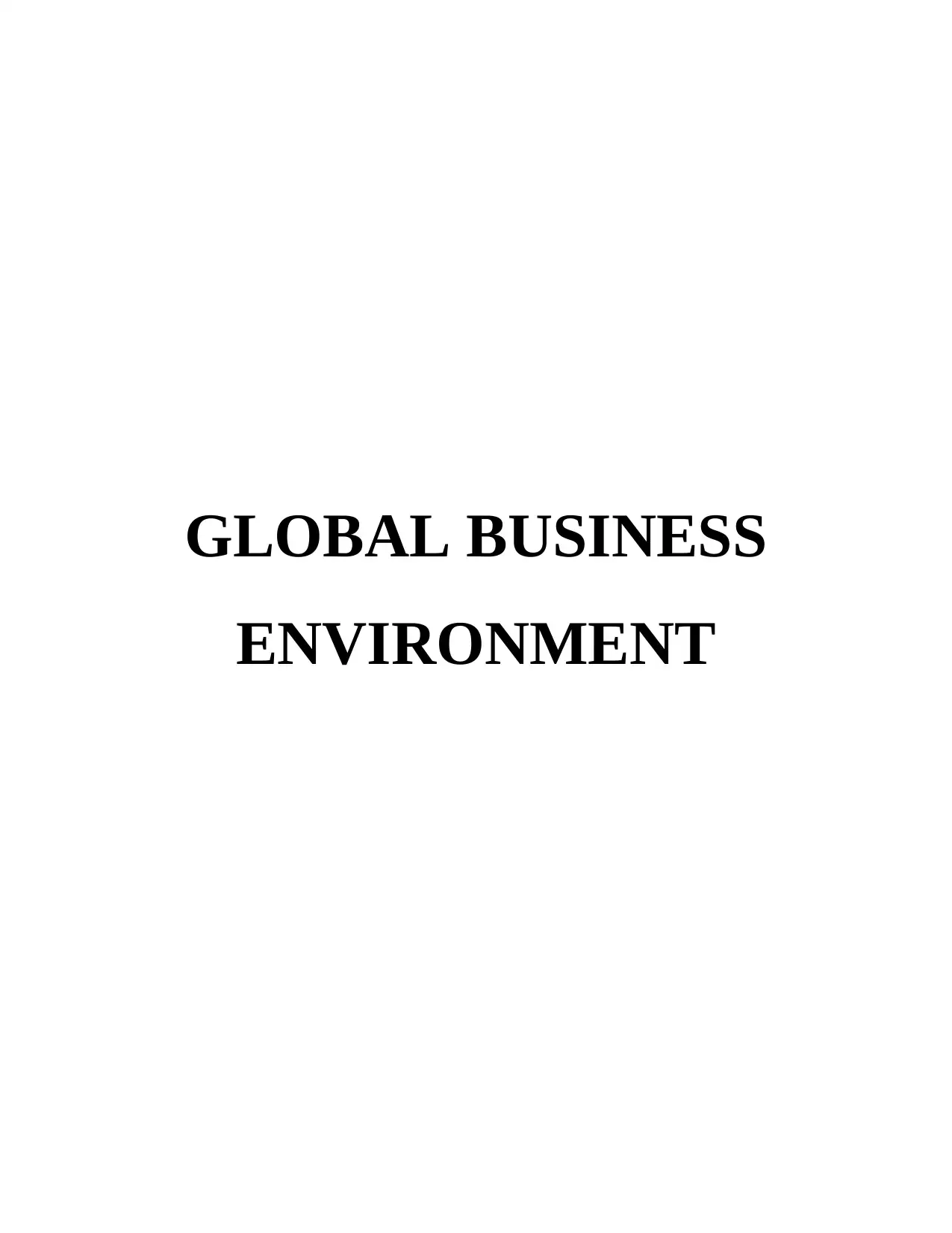
GLOBAL BUSINESS
ENVIRONMENT
ENVIRONMENT
Paraphrase This Document
Need a fresh take? Get an instant paraphrase of this document with our AI Paraphraser


INTRODUCTION
Global business environment refers to environment in different sovereign countries are
exogenous to home environment of firm and impacting capabilities of decision making and
resource use. This is classified in to internal and external environment. In this study, Siemens
AG case study will be used. It is global electronics business that operate its business in Germany.
In given report will mention regarding key factors of market, competition, cost which drive the
trade and global commerce (Black, Morrison and Gregersen, 2013). There will be discussion
about influence of globalisation on leadership, functions, organisational culture and governanace.
Impact of the sustainable globalisation and ethical on the different organisation functions will be
discuss here in a detailed manner.
TASK 1
P1 Key factors of cost, market, environment and competition that drive global commerce and
trade
Globalisation is trend where people as well as countries become minimum influential in
context to cross national bodies. Global commerce is trade among the firms in various countries
or trade between countries. It is selling and purchasing of products among sovereign nations. It
permit the countries to take competitive advantages in some areas while reducing the
disadvantages in the other areas. The global trade and commerce both developed more and also
allowed the firms in less populated regions in order to compete against those which are based in
the more populated regions. Siemens is a multi-national firm and it operate its business in around
190 separate nations. It is global leader in electrical engineering and electronics. The main aim of
this firm is to meet needs of range of the global markets (Botha, Kourie and Snyman, 2014).
Under this, some of the key factors mention below that drive the global commerce and trade:
Cost- Under this, sourcing the efficiency as well as costs are different from one country
to another and international organisations can take the benefit. Enhancement in investment is
motivator for several global organisation. Under this, Siemens use cost cost to conduct the
promotional activities or advertisement at the large scale to aware people about availability of
products and services. The cost factor many be applicable less for services which are mainly
based on people and need to recreating element of service factors in many locations. In order to
1
Global business environment refers to environment in different sovereign countries are
exogenous to home environment of firm and impacting capabilities of decision making and
resource use. This is classified in to internal and external environment. In this study, Siemens
AG case study will be used. It is global electronics business that operate its business in Germany.
In given report will mention regarding key factors of market, competition, cost which drive the
trade and global commerce (Black, Morrison and Gregersen, 2013). There will be discussion
about influence of globalisation on leadership, functions, organisational culture and governanace.
Impact of the sustainable globalisation and ethical on the different organisation functions will be
discuss here in a detailed manner.
TASK 1
P1 Key factors of cost, market, environment and competition that drive global commerce and
trade
Globalisation is trend where people as well as countries become minimum influential in
context to cross national bodies. Global commerce is trade among the firms in various countries
or trade between countries. It is selling and purchasing of products among sovereign nations. It
permit the countries to take competitive advantages in some areas while reducing the
disadvantages in the other areas. The global trade and commerce both developed more and also
allowed the firms in less populated regions in order to compete against those which are based in
the more populated regions. Siemens is a multi-national firm and it operate its business in around
190 separate nations. It is global leader in electrical engineering and electronics. The main aim of
this firm is to meet needs of range of the global markets (Botha, Kourie and Snyman, 2014).
Under this, some of the key factors mention below that drive the global commerce and trade:
Cost- Under this, sourcing the efficiency as well as costs are different from one country
to another and international organisations can take the benefit. Enhancement in investment is
motivator for several global organisation. Under this, Siemens use cost cost to conduct the
promotional activities or advertisement at the large scale to aware people about availability of
products and services. The cost factor many be applicable less for services which are mainly
based on people and need to recreating element of service factors in many locations. In order to
1
⊘ This is a preview!⊘
Do you want full access?
Subscribe today to unlock all pages.

Trusted by 1+ million students worldwide
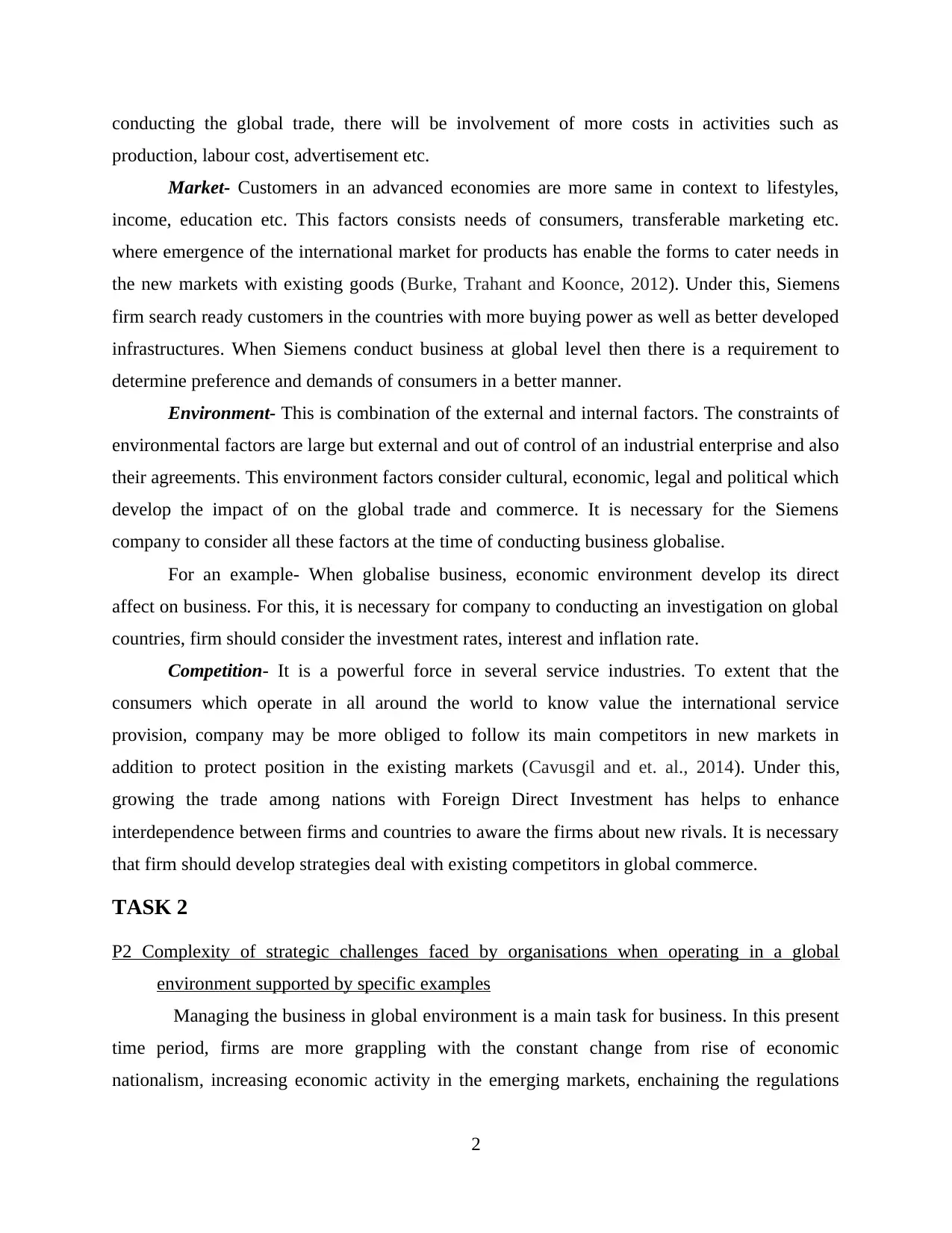
conducting the global trade, there will be involvement of more costs in activities such as
production, labour cost, advertisement etc.
Market- Customers in an advanced economies are more same in context to lifestyles,
income, education etc. This factors consists needs of consumers, transferable marketing etc.
where emergence of the international market for products has enable the forms to cater needs in
the new markets with existing goods (Burke, Trahant and Koonce, 2012). Under this, Siemens
firm search ready customers in the countries with more buying power as well as better developed
infrastructures. When Siemens conduct business at global level then there is a requirement to
determine preference and demands of consumers in a better manner.
Environment- This is combination of the external and internal factors. The constraints of
environmental factors are large but external and out of control of an industrial enterprise and also
their agreements. This environment factors consider cultural, economic, legal and political which
develop the impact of on the global trade and commerce. It is necessary for the Siemens
company to consider all these factors at the time of conducting business globalise.
For an example- When globalise business, economic environment develop its direct
affect on business. For this, it is necessary for company to conducting an investigation on global
countries, firm should consider the investment rates, interest and inflation rate.
Competition- It is a powerful force in several service industries. To extent that the
consumers which operate in all around the world to know value the international service
provision, company may be more obliged to follow its main competitors in new markets in
addition to protect position in the existing markets (Cavusgil and et. al., 2014). Under this,
growing the trade among nations with Foreign Direct Investment has helps to enhance
interdependence between firms and countries to aware the firms about new rivals. It is necessary
that firm should develop strategies deal with existing competitors in global commerce.
TASK 2
P2 Complexity of strategic challenges faced by organisations when operating in a global
environment supported by specific examples
Managing the business in global environment is a main task for business. In this present
time period, firms are more grappling with the constant change from rise of economic
nationalism, increasing economic activity in the emerging markets, enchaining the regulations
2
production, labour cost, advertisement etc.
Market- Customers in an advanced economies are more same in context to lifestyles,
income, education etc. This factors consists needs of consumers, transferable marketing etc.
where emergence of the international market for products has enable the forms to cater needs in
the new markets with existing goods (Burke, Trahant and Koonce, 2012). Under this, Siemens
firm search ready customers in the countries with more buying power as well as better developed
infrastructures. When Siemens conduct business at global level then there is a requirement to
determine preference and demands of consumers in a better manner.
Environment- This is combination of the external and internal factors. The constraints of
environmental factors are large but external and out of control of an industrial enterprise and also
their agreements. This environment factors consider cultural, economic, legal and political which
develop the impact of on the global trade and commerce. It is necessary for the Siemens
company to consider all these factors at the time of conducting business globalise.
For an example- When globalise business, economic environment develop its direct
affect on business. For this, it is necessary for company to conducting an investigation on global
countries, firm should consider the investment rates, interest and inflation rate.
Competition- It is a powerful force in several service industries. To extent that the
consumers which operate in all around the world to know value the international service
provision, company may be more obliged to follow its main competitors in new markets in
addition to protect position in the existing markets (Cavusgil and et. al., 2014). Under this,
growing the trade among nations with Foreign Direct Investment has helps to enhance
interdependence between firms and countries to aware the firms about new rivals. It is necessary
that firm should develop strategies deal with existing competitors in global commerce.
TASK 2
P2 Complexity of strategic challenges faced by organisations when operating in a global
environment supported by specific examples
Managing the business in global environment is a main task for business. In this present
time period, firms are more grappling with the constant change from rise of economic
nationalism, increasing economic activity in the emerging markets, enchaining the regulations
2
Paraphrase This Document
Need a fresh take? Get an instant paraphrase of this document with our AI Paraphraser
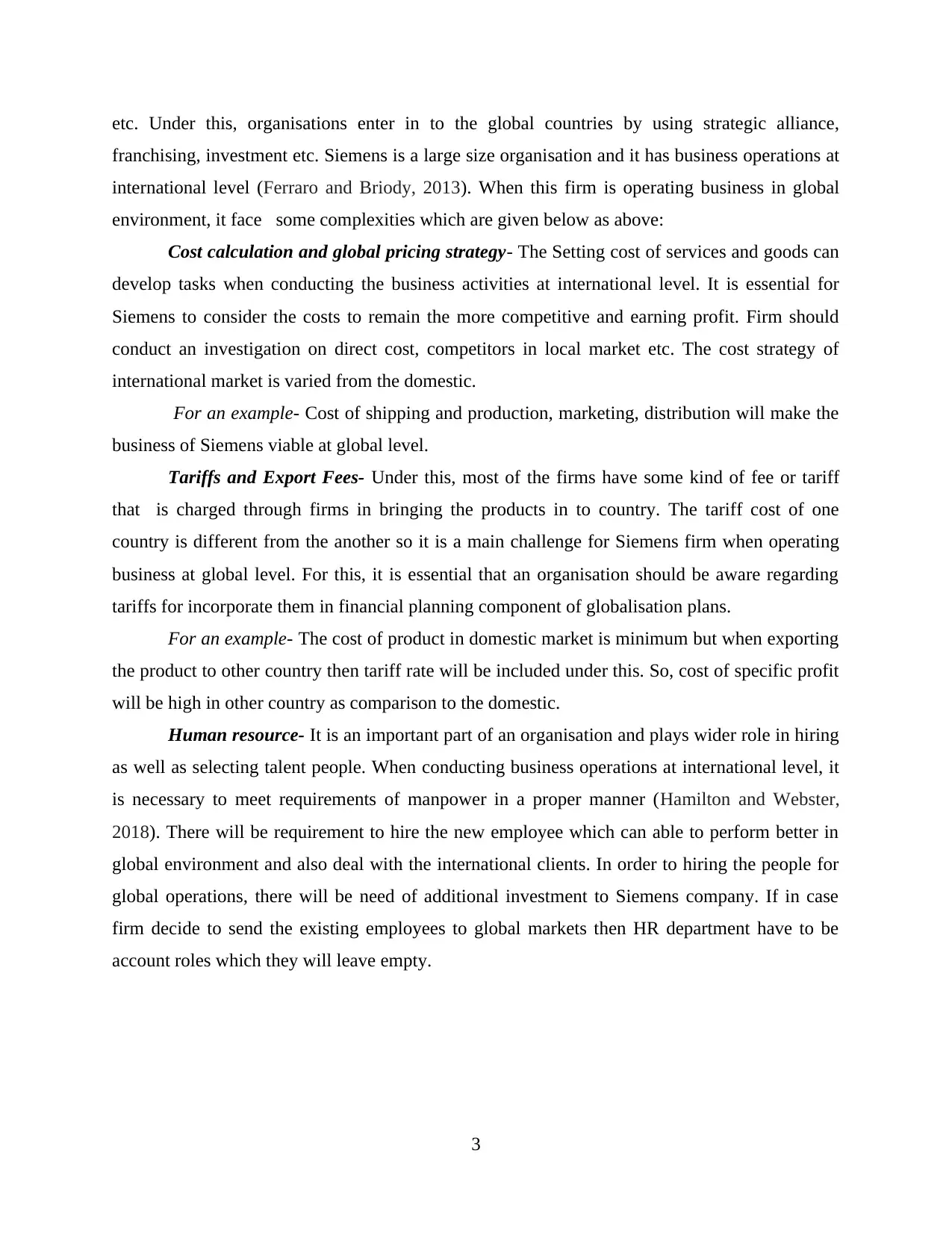
etc. Under this, organisations enter in to the global countries by using strategic alliance,
franchising, investment etc. Siemens is a large size organisation and it has business operations at
international level (Ferraro and Briody, 2013). When this firm is operating business in global
environment, it face some complexities which are given below as above:
Cost calculation and global pricing strategy- The Setting cost of services and goods can
develop tasks when conducting the business activities at international level. It is essential for
Siemens to consider the costs to remain the more competitive and earning profit. Firm should
conduct an investigation on direct cost, competitors in local market etc. The cost strategy of
international market is varied from the domestic.
For an example- Cost of shipping and production, marketing, distribution will make the
business of Siemens viable at global level.
Tariffs and Export Fees- Under this, most of the firms have some kind of fee or tariff
that is charged through firms in bringing the products in to country. The tariff cost of one
country is different from the another so it is a main challenge for Siemens firm when operating
business at global level. For this, it is essential that an organisation should be aware regarding
tariffs for incorporate them in financial planning component of globalisation plans.
For an example- The cost of product in domestic market is minimum but when exporting
the product to other country then tariff rate will be included under this. So, cost of specific profit
will be high in other country as comparison to the domestic.
Human resource- It is an important part of an organisation and plays wider role in hiring
as well as selecting talent people. When conducting business operations at international level, it
is necessary to meet requirements of manpower in a proper manner (Hamilton and Webster,
2018). There will be requirement to hire the new employee which can able to perform better in
global environment and also deal with the international clients. In order to hiring the people for
global operations, there will be need of additional investment to Siemens company. If in case
firm decide to send the existing employees to global markets then HR department have to be
account roles which they will leave empty.
3
franchising, investment etc. Siemens is a large size organisation and it has business operations at
international level (Ferraro and Briody, 2013). When this firm is operating business in global
environment, it face some complexities which are given below as above:
Cost calculation and global pricing strategy- The Setting cost of services and goods can
develop tasks when conducting the business activities at international level. It is essential for
Siemens to consider the costs to remain the more competitive and earning profit. Firm should
conduct an investigation on direct cost, competitors in local market etc. The cost strategy of
international market is varied from the domestic.
For an example- Cost of shipping and production, marketing, distribution will make the
business of Siemens viable at global level.
Tariffs and Export Fees- Under this, most of the firms have some kind of fee or tariff
that is charged through firms in bringing the products in to country. The tariff cost of one
country is different from the another so it is a main challenge for Siemens firm when operating
business at global level. For this, it is essential that an organisation should be aware regarding
tariffs for incorporate them in financial planning component of globalisation plans.
For an example- The cost of product in domestic market is minimum but when exporting
the product to other country then tariff rate will be included under this. So, cost of specific profit
will be high in other country as comparison to the domestic.
Human resource- It is an important part of an organisation and plays wider role in hiring
as well as selecting talent people. When conducting business operations at international level, it
is necessary to meet requirements of manpower in a proper manner (Hamilton and Webster,
2018). There will be requirement to hire the new employee which can able to perform better in
global environment and also deal with the international clients. In order to hiring the people for
global operations, there will be need of additional investment to Siemens company. If in case
firm decide to send the existing employees to global markets then HR department have to be
account roles which they will leave empty.
3

TASK 3
P3 Influences of globalisation on organisational governance and leadership, structure, culture
and functions
Globalisation is wider area concept that commence major components in its business. It
affects an economy, community, environment and business in diverse manner. Globalisation is
helpful in making the trade, communication among two different countries better (Kankaanranta
and Salminen, 2013). Under this, there are some components which affected through
globalisation mention below:
Organisational governance and leadership- The organisational governance is system of
practices, rules and processes through which organisation is directed and controlled. It included
balancing of stakeholders interest like management, financiers, government, community etc.
Under this, organisational governance is relationship among directors, equity capital providers
and managers. During performing business activities at international level, it is necessary that
management, government and all necessary shareholders should be agree on the international
policies. If in case, they will make the different policies on the basis of their opinions then it will
arise the conflict.
On the other hand, The leadership style in each country is varied from another and this is
not essential that better leader in the one country will be better in other. Each country has its own
customs, social standards and beliefs which leader need to understand and include them (Laudon
and Traver, 2016). If leader will not have the proper knowledge about the beliefs, ethics and
customers then it will negatively influence leadership.
Organisational structure- It is a main issue when performing business at international
level. Under this, firm link the organisational functions, geography and departments in order to
attain its objectives. When firm performing its activities at global level then management should
be assure about the proper organisational structure. If the job roles will not be divide proper
manner then in this case it will develop the negative impact on business as well as structure.
Organisational culture- It encompasses values and behaviours which helps in contribute
towards social and psychological environment of business.The culture of every country is
different from the each other and it develop impact on the business. If firm will conduct business
at global level then it need to aware about the other country culture (Popescu, 2013). Without
knowing about the culture, Siemens firm can be negatively impacted.
4
P3 Influences of globalisation on organisational governance and leadership, structure, culture
and functions
Globalisation is wider area concept that commence major components in its business. It
affects an economy, community, environment and business in diverse manner. Globalisation is
helpful in making the trade, communication among two different countries better (Kankaanranta
and Salminen, 2013). Under this, there are some components which affected through
globalisation mention below:
Organisational governance and leadership- The organisational governance is system of
practices, rules and processes through which organisation is directed and controlled. It included
balancing of stakeholders interest like management, financiers, government, community etc.
Under this, organisational governance is relationship among directors, equity capital providers
and managers. During performing business activities at international level, it is necessary that
management, government and all necessary shareholders should be agree on the international
policies. If in case, they will make the different policies on the basis of their opinions then it will
arise the conflict.
On the other hand, The leadership style in each country is varied from another and this is
not essential that better leader in the one country will be better in other. Each country has its own
customs, social standards and beliefs which leader need to understand and include them (Laudon
and Traver, 2016). If leader will not have the proper knowledge about the beliefs, ethics and
customers then it will negatively influence leadership.
Organisational structure- It is a main issue when performing business at international
level. Under this, firm link the organisational functions, geography and departments in order to
attain its objectives. When firm performing its activities at global level then management should
be assure about the proper organisational structure. If the job roles will not be divide proper
manner then in this case it will develop the negative impact on business as well as structure.
Organisational culture- It encompasses values and behaviours which helps in contribute
towards social and psychological environment of business.The culture of every country is
different from the each other and it develop impact on the business. If firm will conduct business
at global level then it need to aware about the other country culture (Popescu, 2013). Without
knowing about the culture, Siemens firm can be negatively impacted.
4
⊘ This is a preview!⊘
Do you want full access?
Subscribe today to unlock all pages.

Trusted by 1+ million students worldwide
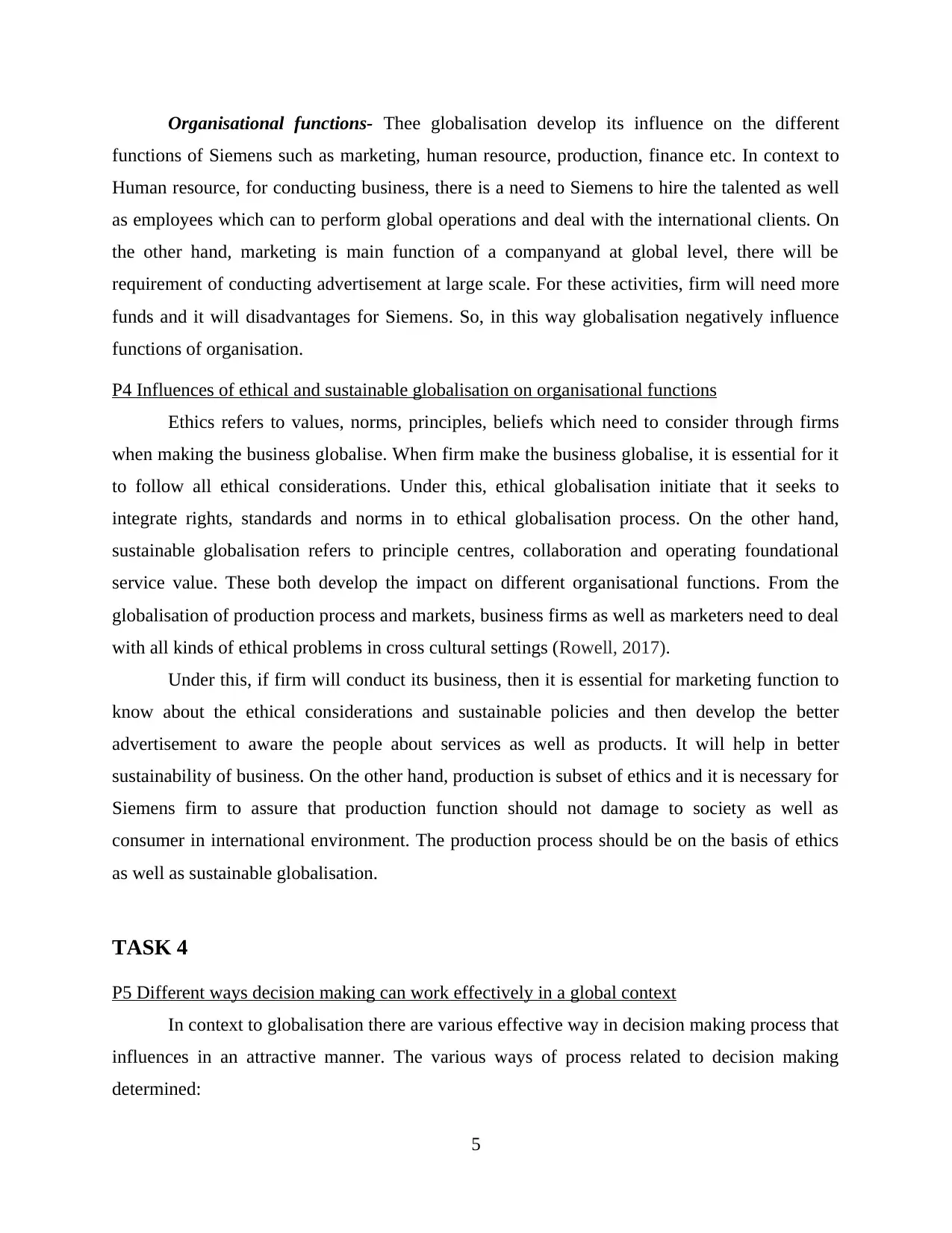
Organisational functions- Thee globalisation develop its influence on the different
functions of Siemens such as marketing, human resource, production, finance etc. In context to
Human resource, for conducting business, there is a need to Siemens to hire the talented as well
as employees which can to perform global operations and deal with the international clients. On
the other hand, marketing is main function of a companyand at global level, there will be
requirement of conducting advertisement at large scale. For these activities, firm will need more
funds and it will disadvantages for Siemens. So, in this way globalisation negatively influence
functions of organisation.
P4 Influences of ethical and sustainable globalisation on organisational functions
Ethics refers to values, norms, principles, beliefs which need to consider through firms
when making the business globalise. When firm make the business globalise, it is essential for it
to follow all ethical considerations. Under this, ethical globalisation initiate that it seeks to
integrate rights, standards and norms in to ethical globalisation process. On the other hand,
sustainable globalisation refers to principle centres, collaboration and operating foundational
service value. These both develop the impact on different organisational functions. From the
globalisation of production process and markets, business firms as well as marketers need to deal
with all kinds of ethical problems in cross cultural settings (Rowell, 2017).
Under this, if firm will conduct its business, then it is essential for marketing function to
know about the ethical considerations and sustainable policies and then develop the better
advertisement to aware the people about services as well as products. It will help in better
sustainability of business. On the other hand, production is subset of ethics and it is necessary for
Siemens firm to assure that production function should not damage to society as well as
consumer in international environment. The production process should be on the basis of ethics
as well as sustainable globalisation.
TASK 4
P5 Different ways decision making can work effectively in a global context
In context to globalisation there are various effective way in decision making process that
influences in an attractive manner. The various ways of process related to decision making
determined:
5
functions of Siemens such as marketing, human resource, production, finance etc. In context to
Human resource, for conducting business, there is a need to Siemens to hire the talented as well
as employees which can to perform global operations and deal with the international clients. On
the other hand, marketing is main function of a companyand at global level, there will be
requirement of conducting advertisement at large scale. For these activities, firm will need more
funds and it will disadvantages for Siemens. So, in this way globalisation negatively influence
functions of organisation.
P4 Influences of ethical and sustainable globalisation on organisational functions
Ethics refers to values, norms, principles, beliefs which need to consider through firms
when making the business globalise. When firm make the business globalise, it is essential for it
to follow all ethical considerations. Under this, ethical globalisation initiate that it seeks to
integrate rights, standards and norms in to ethical globalisation process. On the other hand,
sustainable globalisation refers to principle centres, collaboration and operating foundational
service value. These both develop the impact on different organisational functions. From the
globalisation of production process and markets, business firms as well as marketers need to deal
with all kinds of ethical problems in cross cultural settings (Rowell, 2017).
Under this, if firm will conduct its business, then it is essential for marketing function to
know about the ethical considerations and sustainable policies and then develop the better
advertisement to aware the people about services as well as products. It will help in better
sustainability of business. On the other hand, production is subset of ethics and it is necessary for
Siemens firm to assure that production function should not damage to society as well as
consumer in international environment. The production process should be on the basis of ethics
as well as sustainable globalisation.
TASK 4
P5 Different ways decision making can work effectively in a global context
In context to globalisation there are various effective way in decision making process that
influences in an attractive manner. The various ways of process related to decision making
determined:
5
Paraphrase This Document
Need a fresh take? Get an instant paraphrase of this document with our AI Paraphraser
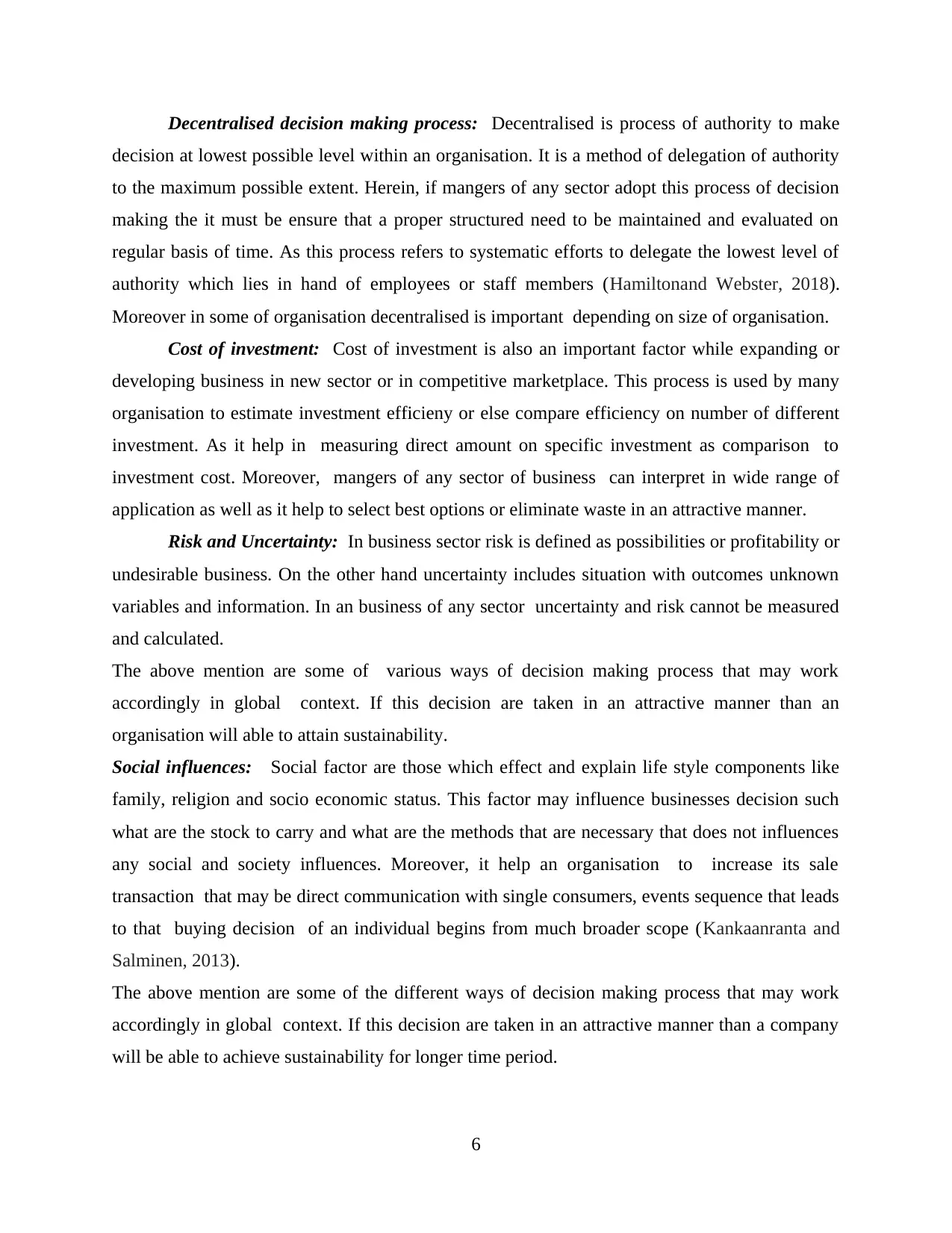
Decentralised decision making process: Decentralised is process of authority to make
decision at lowest possible level within an organisation. It is a method of delegation of authority
to the maximum possible extent. Herein, if mangers of any sector adopt this process of decision
making the it must be ensure that a proper structured need to be maintained and evaluated on
regular basis of time. As this process refers to systematic efforts to delegate the lowest level of
authority which lies in hand of employees or staff members (Hamiltonand Webster, 2018).
Moreover in some of organisation decentralised is important depending on size of organisation.
Cost of investment: Cost of investment is also an important factor while expanding or
developing business in new sector or in competitive marketplace. This process is used by many
organisation to estimate investment efficieny or else compare efficiency on number of different
investment. As it help in measuring direct amount on specific investment as comparison to
investment cost. Moreover, mangers of any sector of business can interpret in wide range of
application as well as it help to select best options or eliminate waste in an attractive manner.
Risk and Uncertainty: In business sector risk is defined as possibilities or profitability or
undesirable business. On the other hand uncertainty includes situation with outcomes unknown
variables and information. In an business of any sector uncertainty and risk cannot be measured
and calculated.
The above mention are some of various ways of decision making process that may work
accordingly in global context. If this decision are taken in an attractive manner than an
organisation will able to attain sustainability.
Social influences: Social factor are those which effect and explain life style components like
family, religion and socio economic status. This factor may influence businesses decision such
what are the stock to carry and what are the methods that are necessary that does not influences
any social and society influences. Moreover, it help an organisation to increase its sale
transaction that may be direct communication with single consumers, events sequence that leads
to that buying decision of an individual begins from much broader scope (Kankaanranta and
Salminen, 2013).
The above mention are some of the different ways of decision making process that may work
accordingly in global context. If this decision are taken in an attractive manner than a company
will be able to achieve sustainability for longer time period.
6
decision at lowest possible level within an organisation. It is a method of delegation of authority
to the maximum possible extent. Herein, if mangers of any sector adopt this process of decision
making the it must be ensure that a proper structured need to be maintained and evaluated on
regular basis of time. As this process refers to systematic efforts to delegate the lowest level of
authority which lies in hand of employees or staff members (Hamiltonand Webster, 2018).
Moreover in some of organisation decentralised is important depending on size of organisation.
Cost of investment: Cost of investment is also an important factor while expanding or
developing business in new sector or in competitive marketplace. This process is used by many
organisation to estimate investment efficieny or else compare efficiency on number of different
investment. As it help in measuring direct amount on specific investment as comparison to
investment cost. Moreover, mangers of any sector of business can interpret in wide range of
application as well as it help to select best options or eliminate waste in an attractive manner.
Risk and Uncertainty: In business sector risk is defined as possibilities or profitability or
undesirable business. On the other hand uncertainty includes situation with outcomes unknown
variables and information. In an business of any sector uncertainty and risk cannot be measured
and calculated.
The above mention are some of various ways of decision making process that may work
accordingly in global context. If this decision are taken in an attractive manner than an
organisation will able to attain sustainability.
Social influences: Social factor are those which effect and explain life style components like
family, religion and socio economic status. This factor may influence businesses decision such
what are the stock to carry and what are the methods that are necessary that does not influences
any social and society influences. Moreover, it help an organisation to increase its sale
transaction that may be direct communication with single consumers, events sequence that leads
to that buying decision of an individual begins from much broader scope (Kankaanranta and
Salminen, 2013).
The above mention are some of the different ways of decision making process that may work
accordingly in global context. If this decision are taken in an attractive manner than a company
will be able to achieve sustainability for longer time period.
6

P6 Various routes to internationalisation an organisation may adopt, including key barriers
Firm use different ways to making business internationalise for the purpose of getting
better opportunities (Salvatore, 2015). Under this, there are different routes to
internationalisation which Siemens can adopt mention below:
Joint venture- It is partnership among the two people or firms. Under this, both
organisations make equal investment in project and split the profit accordingly. Siemens firm do
the joint venture with the local firm in another country. It will help in giving advantages to the
business to aware about the local markets and preferences of customers.
The main issues included in joint venture are related with the clash of culture, complex
to exit partnership if there is contract involved, lack of the clear communication etc.
Licensing- Global licensing a kind of cross border agreement that permit firm in target
country for the right to use property of licensor. For conducting the business in the other country,
there will be requirement of license and it is necessary to pay fee in exchange of rights which are
specified in contract among parties. With the licensing, Siemens firm will able to enter in
international market. Issues which company faced in licensing are risk of incompetent
international partner company and minimum income level as comparison to the other
international expansion modes (. Savrul, Incekara and Sener, 2014).
Franchising- It is an effective internationalisation way where semi- independent business
owner that pay fees and royalties to franchiser to use trademark of firm and sell its services or
products. Terms and conditions related to franchising are mention on contract and these are
basically related with the management, equipment, staff training, operations and many others. On
the other hand, there are some of the issues which firm can face in internationalisation of
business such as reduced brand equity, not enhancing profit etc.
Exporting- It is cross border sale for produced the services and products. Exporting are
of three different kinds such as direct, cooperative and indirect exporting. With the help of
exporting, Siemens can enter in to the new global market. Mainly, the firms use indirect export
to making business internationalised in order to see if global market is repetitive of brand
(Shenkar, Luoand Chi, 2014). The issues which company face in exporting are conduct research
at global market, more fund expenditure etc.
7
Firm use different ways to making business internationalise for the purpose of getting
better opportunities (Salvatore, 2015). Under this, there are different routes to
internationalisation which Siemens can adopt mention below:
Joint venture- It is partnership among the two people or firms. Under this, both
organisations make equal investment in project and split the profit accordingly. Siemens firm do
the joint venture with the local firm in another country. It will help in giving advantages to the
business to aware about the local markets and preferences of customers.
The main issues included in joint venture are related with the clash of culture, complex
to exit partnership if there is contract involved, lack of the clear communication etc.
Licensing- Global licensing a kind of cross border agreement that permit firm in target
country for the right to use property of licensor. For conducting the business in the other country,
there will be requirement of license and it is necessary to pay fee in exchange of rights which are
specified in contract among parties. With the licensing, Siemens firm will able to enter in
international market. Issues which company faced in licensing are risk of incompetent
international partner company and minimum income level as comparison to the other
international expansion modes (. Savrul, Incekara and Sener, 2014).
Franchising- It is an effective internationalisation way where semi- independent business
owner that pay fees and royalties to franchiser to use trademark of firm and sell its services or
products. Terms and conditions related to franchising are mention on contract and these are
basically related with the management, equipment, staff training, operations and many others. On
the other hand, there are some of the issues which firm can face in internationalisation of
business such as reduced brand equity, not enhancing profit etc.
Exporting- It is cross border sale for produced the services and products. Exporting are
of three different kinds such as direct, cooperative and indirect exporting. With the help of
exporting, Siemens can enter in to the new global market. Mainly, the firms use indirect export
to making business internationalised in order to see if global market is repetitive of brand
(Shenkar, Luoand Chi, 2014). The issues which company face in exporting are conduct research
at global market, more fund expenditure etc.
7
⊘ This is a preview!⊘
Do you want full access?
Subscribe today to unlock all pages.

Trusted by 1+ million students worldwide

Among all these ways of making the business internalise, Siemens can use Exporting
because under this less risk involves, it will need less commitment and also get the brand
exposure to new market.
CONCLUSION
From above mention report, it has been concluded that globalisation provides the various
opportunities to an organisation while conducting business at international level. It is necessary
that firm should be aware about the language, norms, values, communication style etc. At
performing the business operations at global level, cost, environment, market and competition all
are the main factors and it is a responsibility of an organisation to consider all these factors at the
time of globalised business. There has been discussed about the impact of globalisation on
leadership, organisational functions, organisational governance and culture in a detailed manner.
8
because under this less risk involves, it will need less commitment and also get the brand
exposure to new market.
CONCLUSION
From above mention report, it has been concluded that globalisation provides the various
opportunities to an organisation while conducting business at international level. It is necessary
that firm should be aware about the language, norms, values, communication style etc. At
performing the business operations at global level, cost, environment, market and competition all
are the main factors and it is a responsibility of an organisation to consider all these factors at the
time of globalised business. There has been discussed about the impact of globalisation on
leadership, organisational functions, organisational governance and culture in a detailed manner.
8
Paraphrase This Document
Need a fresh take? Get an instant paraphrase of this document with our AI Paraphraser
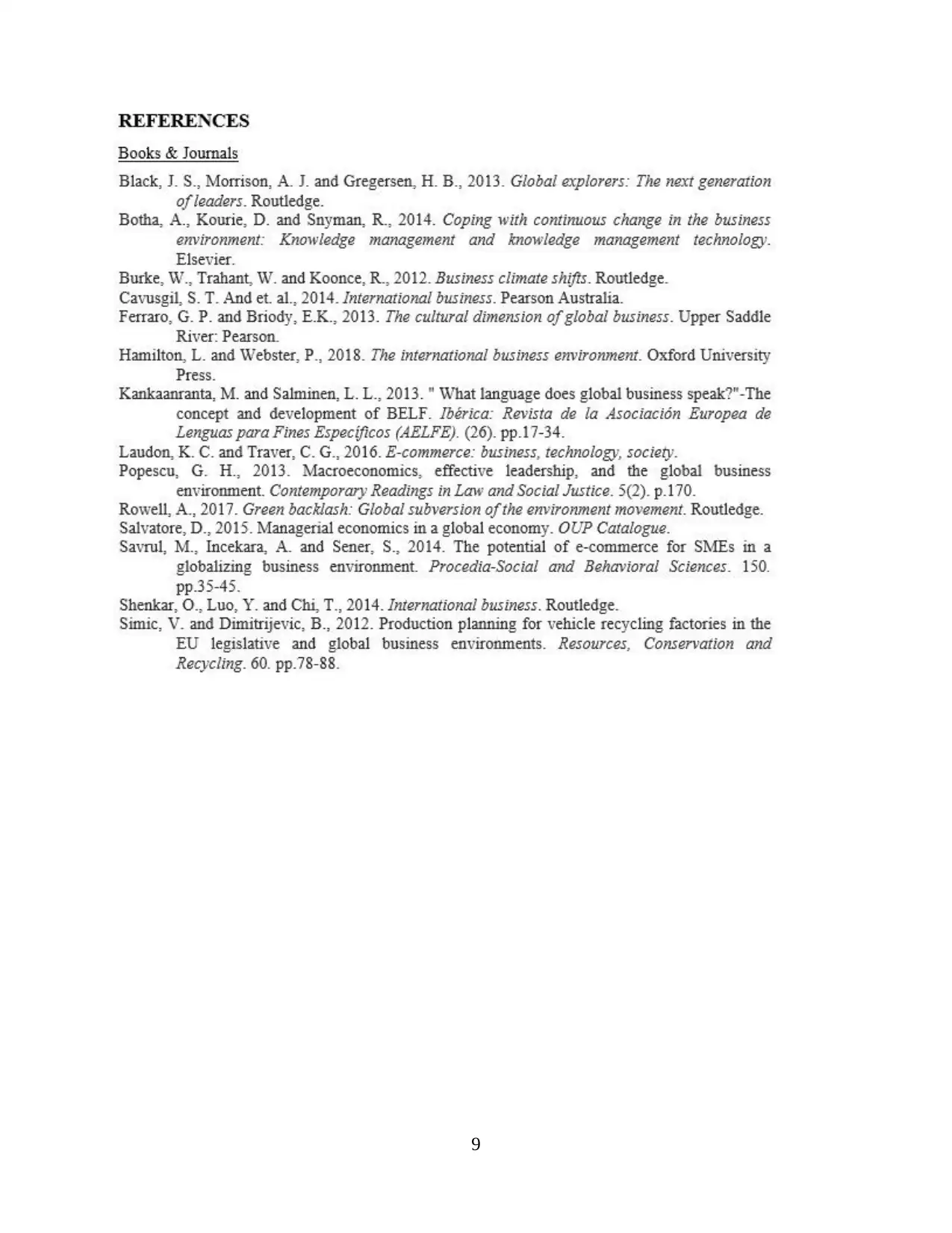
9
1 out of 11
Related Documents
Your All-in-One AI-Powered Toolkit for Academic Success.
+13062052269
info@desklib.com
Available 24*7 on WhatsApp / Email
![[object Object]](/_next/static/media/star-bottom.7253800d.svg)
Unlock your academic potential
Copyright © 2020–2025 A2Z Services. All Rights Reserved. Developed and managed by ZUCOL.


![Strategic Challenges & Global Commerce: CAMECO Report, [Course Name]](/_next/image/?url=https%3A%2F%2Fdesklib.com%2Fmedia%2Fimages%2Fjc%2Fc486c00570d04b6a821efb0b3a00a464.jpg&w=256&q=75)


